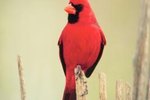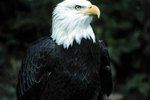
The annual migration of tens of thousands of North American swans, from wintering grounds in temperate climates to summer nesting sites throughout the Arctic, is a marathon without parallel in human experience. Starting points vary depending upon the locales of individual populations but, according to the Arctic National Wildlife Refuge, swans cover on average more than 4,000 miles.
Native North American Species
Two swan species are native to North America. In summer, both migrate to the Arctic for breeding and nesting. Male trumpeter swans, one of the world's largest water birds, can weigh up to 28 pounds, with females a few pounds lighter; tundra swans are less than two-thirds that size. From a distance, the two species look alike; but trumpeters have all-black bills, while most tundra swans have a yellow patch on theirs. By 1932, trumpeters had been hunted almost to extinction for their meat and feathers -- only 69 remained in the wild -- but after a previously unknown breeding population was discovered in Alaska, numbers slowly began rising. Tundra swans were also overhunted but never as critically endangered as trumpeters.
The Invasive Mute Swan
Ironically, the swan most familiar to North Americans, the mute swan, is neither native to North America nor migratory -- it stays put year-round. Not long after this species was brought over from Europe in the 1900s to ornament the estates of rich people, mute swans went feral and quickly established themselves in the same areas where indigenous swans lived, driving them out and overconsuming the available food supply. You can recognize them from their lovely S-shaped necks and bright orange and black bills. Unlike North American swans, mute swans are very aggressive and will attack people as well as other swans and species of waterfowl.
Migration Routes
Both species of North American swan have eastern and western populations that follow different migration routes but usually touch down in the same places at much the same times every year. Throughout February, tundra swans take off from their wintering grounds in the Atlantic states and North Carolina, and arrive in southern Ontario in early March. For a couple of weeks, they make themselves at home in boggy farmers' fields, eating corn or wheat residue from the last harvest and bulking up for the next leg of their exhausting journey. Every April in Marsh Lake in Canada's Yukon territory, a nine-day "Celebration of Swans" festival welcomes trumpeters back to the North from their last major stopover point on Vancouver Island. From there, these swans continue on to their final destination in Alaska.
Breeding Habits
According to the Alaska Department of Fish and Game, swans pair up for life, usually around the age of 2, but typically don't start breeding until the age of 3, 4 or 5. Cygnets require a long period of development before they are strong enough to embark on the reverse migration, so when the swans reach the Arctic from May to mid-June, they start nest-building immediately. Trumpeters usually build on marshland beside small lakes, while tundra swans look for elevated nesting sites near larger bodies of water. Depending upon the weather, swans begin heading back to their wintering grounds in late September or early October, flying together either as families or in small flocks.
References
- CBC News: Yukon Celebrates Trumpeter Swan Migration
- Environment Yukon: A Celebration of Swans
- Long Point Waterfowl: Tracking Tundra Swans by Satellite
- The Swan Sanctuary: Swan Species - Tribe Cygnini
- North Carolina Wildlife: Tundra Swan
- National Geographic: Tundra Swan
- U.S. Fish and Wildlife Service: Arctic National Wildlife Refuge
- Alaska Department of Fish and Game: Swan
- Government of Michigan: Why Are Mute Swans a Problem?
Photo Credits
-
Tom Brakefield/Stockbyte/Getty Images




